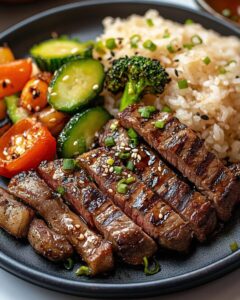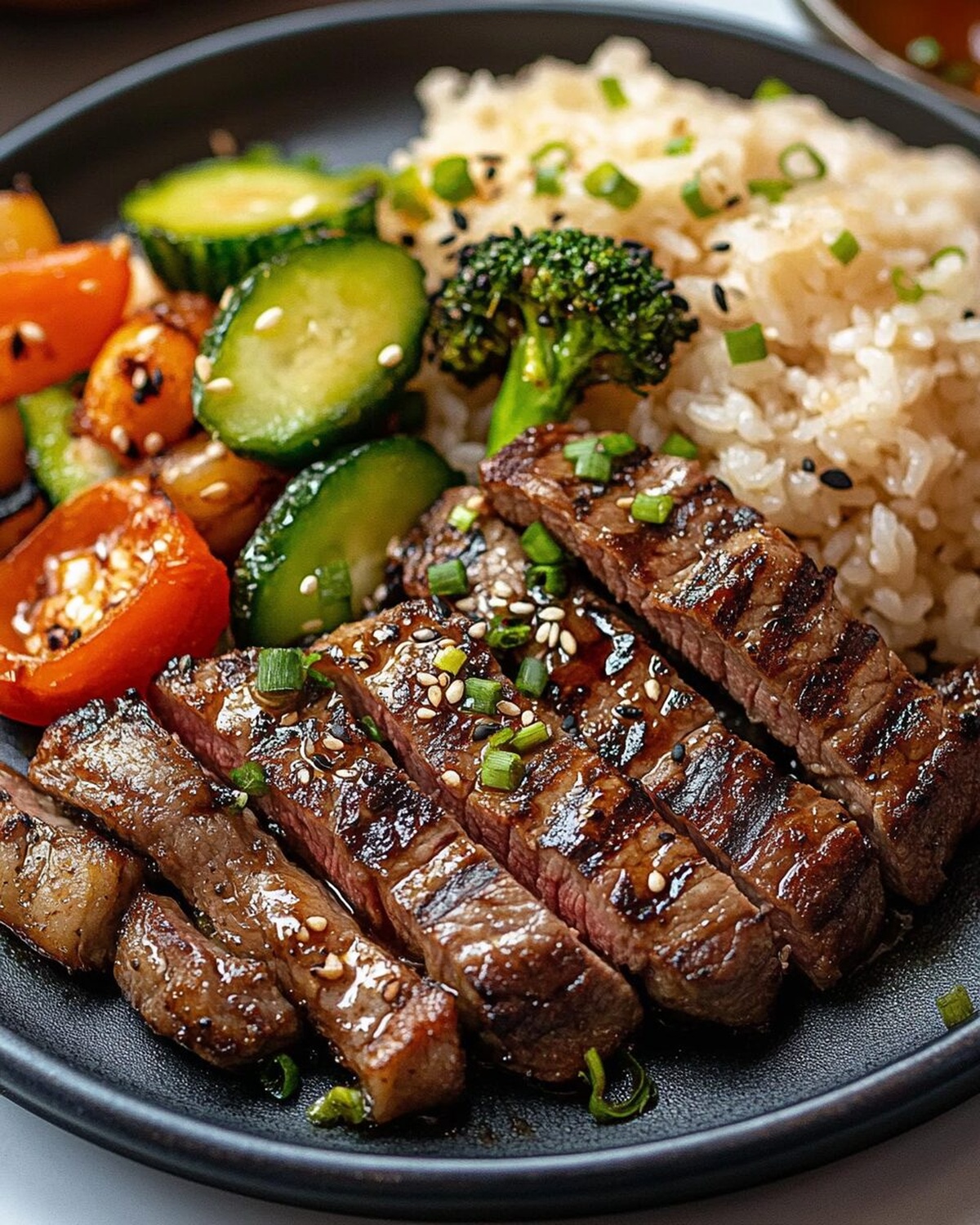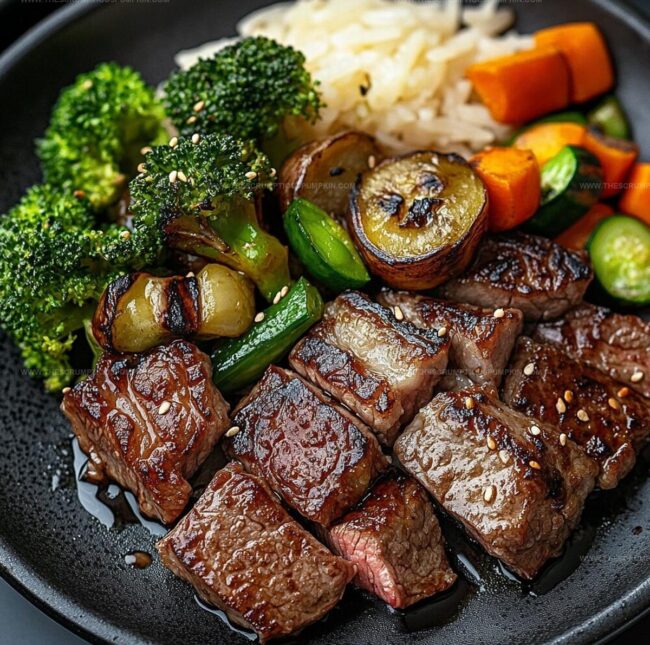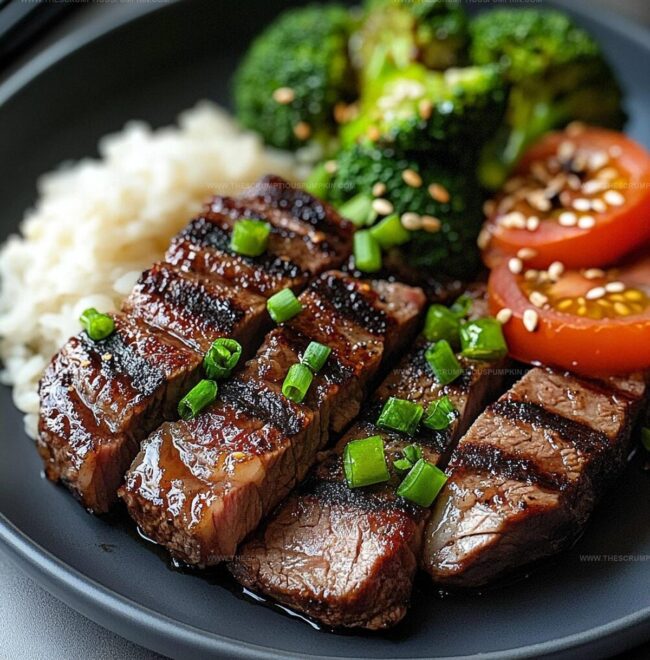The Perfect Hibachi Steak Recipe for a Sizzling Home Feast
Crafting a mouthwatering hibachi steak invites culinary adventure right into your kitchen.
Sizzling techniques from Japanese steakhouses inspire this home-cooked masterpiece.
Professional chefs carefully select premium cuts for maximum flavor intensity.
Tender beef transforms when marinated with simple yet bold seasonings.
Precise cooking methods ensure restaurant-quality results without complicated equipment.
Skilled home cooks can recreate these delectable restaurant flavors with minimal effort.
You’ll love mastering this impressive dish that guarantees dinner table excitement.
What Makes Hibachi Steak So Good
What Goes Into Hibachi Steak
Main Protein:Vegetables:Aromatics and Seasonings:Cooking Liquids and Sauces:How To Make Hibachi Steak Step By Step
Step 1: Season and Sear the Steak
Generously sprinkle salt and pepper over the steak pieces. Heat vegetable oil in a large skillet or wok over medium-high heat.
Carefully place the steak into the hot pan and cook until a beautiful golden-brown crust forms, about 2-3 minutes on each side. Transfer the perfectly seared steak to a plate and set aside.
Step 2: Sauté Vibrant Vegetables
In the same pan, add more vegetable oil and a splash of sesame oil. Toss in the ingredients:Sauté the vegetables until they become soft and slightly caramelized, about 4-5 minutes.
Add zucchini and continue cooking for an additional 2-3 minutes.
Step 3: Infuse Aromatic Garlic
Push the vegetables to one side of the pan.
Drop a pat of butter into the empty space and let it melt. Quickly add minced garlic and sauté for a brief 30 seconds until the kitchen fills with an irresistible fragrant aroma.
Step 4: Create Flavor-Packed Sauce
In a small bowl, whisk together:Pour this magical sauce mixture into the pan with the vegetables, creating a simmering symphony of flavors.
Step 5: Combine and Simmer
Gently return the seared steak to the pan.
Stir everything together, allowing the sauce to embrace the steak and vegetables. Let the mixture simmer for 1-2 minutes until the sauce becomes slightly thickened and glossy.
Finish by stirring in a final pat of butter for extra richness.
Step 6: Garnish and Serve
Remove the pan from heat.
Sprinkle sesame seeds and freshly sliced green onions over the top. Serve piping hot alongside hibachi fried rice or a dollop of creamy yum yum sauce for an authentic hibachi experience.
Helpful Tips For Cooking Hibachi Steak
Ways To Change Up Hibachi Steak
Best Sides To Serve With Hibachi Steak
How To Store Leftover Hibachi Steak
Top Questions About Hibachi Steak
Ribeye, sirloin, or flank steak are ideal choices. They provide great flavor and tenderness when cooked quickly at high heat.
Yes, use tamari instead of traditional soy sauce to create a gluten-free version of this hibachi steak dish.
No, this hibachi steak recipe is not spicy. It features a sweet and savory sauce with mild seasonings that enhance the meat’s natural flavor.
For medium-rare, cook steak pieces until they have a nice brown exterior and reach an internal temperature of 135°F using a meat thermometer.
Print
Hibachi Steak Recipe
- Total Time: 25 minutes
- Yield: 4 1x
Description
Sizzling Japanese hibachi steak delivers restaurant-quality flavor right from your home kitchen. Juicy marinated beef, expertly grilled with savory seasonings, promises a delicious meal you’ll crave again and again.
Ingredients
Protein:
- 1 pound (454 grams) sirloin or NY strip steak, cut into bite-sized pieces
Vegetables:
- 8 ounces (226 grams) white mushrooms, sliced
- 1 large onion, sliced
- 2 zucchini, cut into 1/2-inch sticks
Seasonings and Sauces:
- 2 tablespoons (30 milliliters) vegetable oil, divided
- 1 teaspoon (5 milliliters) sesame oil
- 2 tablespoons (28 grams) butter, divided
- 4 cloves garlic, minced
- 1/4 cup (60 milliliters) soy sauce
- 1 tablespoon (15 milliliters) mirin (Japanese sweet rice wine)
- 1 teaspoon (5 milliliters) honey
- Salt and pepper to taste
Garnish:
- Sesame seeds
- Sliced green onions
Instructions
- Generously season steak pieces with salt and pepper, ensuring even coating.
- Heat vegetable oil in a large skillet over medium-high heat (375°F). Sear steak for 2-3 minutes per side until golden brown and slightly crispy. Transfer to a plate and set aside.
- In the same pan, add remaining vegetable and sesame oils. Introduce sliced mushrooms and onions, sautéing for 4-5 minutes until they become translucent and tender.
- Add zucchini to the vegetable mixture, cooking for an additional 2-3 minutes until slightly softened.
- Create a small space in the pan and melt butter. Quickly sauté minced garlic for 30 seconds, releasing its aromatic essence.
- Whisk soy sauce, mirin, and honey in a small bowl, creating a harmonious flavor blend.
- Pour the sauce mixture into the pan, coating the vegetables evenly.
- Reintroduce the seared steak to the pan, gently stirring to combine all ingredients.
- Allow the sauce to simmer for 1-2 minutes, reducing and thickening slightly.
- Incorporate the remaining butter, creating a glossy and rich finish.
- Remove from heat and sprinkle with sesame seeds and sliced green onions.
- Serve immediately alongside hibachi fried rice or yum yum sauce for a complete dining experience.
Notes
- Choose a tender cut like ribeye or sirloin for the most flavorful and juicy hibachi steak.
- Pat the steak dry before seasoning to ensure a perfect golden-brown sear and prevent steaming.
- Let the steak rest at room temperature for 15-20 minutes before cooking to promote even cooking.
- Slice the steak against the grain for maximum tenderness and easier chewing.
- Use a cast-iron skillet or heavy-bottomed pan to achieve the best high-heat searing.
- Customize the dish by adding other vegetables like bell peppers or carrots for extra nutrition and color.
- Make it gluten-free by using tamari instead of traditional soy sauce.
- Keep the vegetables crisp-tender by avoiding overcooking to maintain their texture and nutrients.
- Prep Time: 10 minutes
- Cook Time: 15 minutes
- Category: Dinner, Appetizer
- Method: Sautéing
- Cuisine: Japanese
Nutrition
- Serving Size: 4
- Calories: 400
- Sugar: 3 g
- Sodium: 800 mg
- Fat: 25 g
- Saturated Fat: 8 g
- Unsaturated Fat: 15 g
- Trans Fat: 0 g
- Carbohydrates: 12 g
- Fiber: 2 g
- Protein: 30 g
- Cholesterol: 80 mg




Mia Thompson
Pastry Chef & Content Creator
Expertise
Education
Portland Community College – Baking and Pastry Arts Program
Specialized in artisanal bread, seasonal desserts, and sustainable baking methods.
National University of Natural Medicine – Bachelor of Science in Nutrition (BScN)
Focused on “Food as Medicine” philosophy, with core threads in nutrition.
Mia’s love affair with baking began in her grandmother’s kitchen, where sneaking spoonfuls of batter first sparked her curiosity. She refined her skills through Portland Community College’s Baking and Pastry Arts Program and her expertise at the National University of Natural Medicine, earning a B.Sc. in Nutrition.
At The Scrumptious Pumpkin, Mia reimagines classics with effortless seasonal treats, healthier twists on old favorites, and playful confections that feel like pure joy. Beyond the oven, she nurtures her urban garden, forages local ingredients around Portland, and leads hands‑on nutrition workshops for her community.